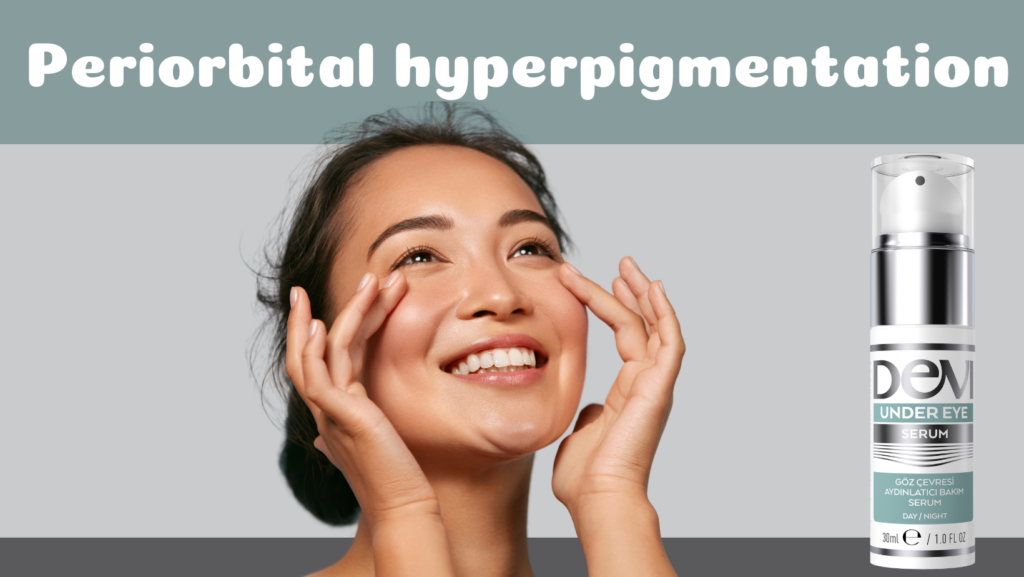When we meet someone for the first time, we instinctively draw conclusions about the person based on their appearance. We first look at their face, specifically the eyes and the area around the eyes, which can tell us a lot. Studies have proven that we draw conclusions about someone’s age and how tired or rested they are based on the appearance of the area around the eyes. Puffy or dark circles around the eyes, also known as periorbital hyperpigmentation, are often clear indicators of numerous factors and not just the degree of fatigue.
Although they are most often associated with fatigue and a lack of sleep, dark circles under the eyes can, among other things, be an indication of a diseases, infections, allergies, stress, hormonal changes, slowed lymph flow, dehydration, lack of nutrients, excessive consumption of alcohol and tobacco, depression, as well as the use of certain medications, oral contraceptives, non-steroidal anti-inflammatory drugs or chemotherapy.
Anatomical features in the area around the eyes also contribute to skin colour changes: the skin around the eyes and on the eyelids is very thin and the bone structure and contours of the eye socket are such that they easily cast a shadow on the under-eye area. The skin of the lower eyelid and around it is delicate and transparent, and as the subcutaneous tissue here is minimal or non-existent, the tone of the skin is highly dependent on the orbicularis oculi muscle. This is why the changes caused by aging are visible much earlier and more clearly in this area than in other parts of the facial skin. The situation can be worsened by genetics – dark circles can be hereditary. This can also be worsened by excessive exposure to the sun.
According to estimates, US women spend 15,000 dollars on average on cosmetics during their lifetime; a large percentage of that sum is spent on cosmetic preparations for the dark circles under the eyes. Even more money goes to surgery – cosmetic surgery of the eyelids and the dark circles under the eyes is the third most common surgery in the USA. Is surgery really necessary? Are there ways to take care of these dark circles and prevent, reduce and eliminate their darkening and puffiness in a natural way? Fortunately, cosmetology has progressed a lot lately and has brought good news.
HOW TO AVOID PUFFY AND DARK CIRCLES UNDER THE EYES?
Of course, it is important to know what causes the dark circles. If we are in good health and we provide our body with everything it needs – a sufficient intake of liquids, healthy foods and nutrients, sleep and physical activity, yet the area around the eyes still remains dominated by hyperpigmentation and wrinkles, there are tricks to turn that situation around.
Peptides are powerful weapons in the cosmetic arsenal today. These short polymers of amino acids connected by peptide bonds are necessary for normal cellular communication and the functioning of the extracellular matrix, the connective tissue produced by fibroblasts. This intercellular space, made up of proteins, collagen fibres, elastin, reticulin and binding proteins, represents the “terrain” for metabolic exchange at the cellular level within all tissues and organs. In addition to providing support and structure to cells, the extracellular matrix plays a major role in the recovery of damaged tissue. Peptides are the building blocks of proteins such as elastin and collagen. Therefore, they are an indispensable ingredient of good quality anti-aging cosmetics. Today, we have peptides such as SYN-AKE and argireline that are so effective that they can be compared to Botox. These peptides are inhibitors of neurotransmitters, which effectively eliminate mimic wrinkles that are especially pronounced in the corners of the eyes and improve the skin’s elasticity. That is why Argireline (acetyl hexapeptide 8), is popularly known as “Botox in a jar”. Argireline helps bind water inside the skin and thus contributes to its better hydration, alongside promoting the production of type 1 collagen. Its regular use over 30 consecutive days reduces the depth of wrinkles by 30 per cent.

Rice and soy peptides, in addition to promoting collagen synthesis, protect against the harmful effects of UV radiation and inhibit the enzyme tyrosinase, which is responsible for hyperpigmentation – dark skin colour, spots and freckles. In addition to their preventive action, they can repair damage at the cellular level caused by the sun’s rays; the rice peptide also has antioxidant properties, so it protects the skin from damage caused by free radicals. These peptides are particularly useful for the care of the area around the eyes prone to darkening and puffiness and contribute to the skin’s lighter tone and evenness. In addition, they are known for their ability to hydrate and nourish the skin, as well as to soothe skin prone to irritation and redness.
The palmitoyl peptide complex is a combination of ingredients that is particularly effective in eliminating dark circles around the eyes, while also preventing irritation and significantly strengthening the skin around the eyes. Results of research into these peptides have shown that after 56 days of application they reduce the appearance of dark circles by over 70 per cent.
HYALURON, VITAMINS, MEDICINAL PLANTS…
Hyaluronic acid is perhaps the most important component of the extracellular matrix. It is the first substance to intervene at the site of injury: it binds to fibrinogen, which creates a protective film, promotes regeneration and enables immune cells to defend the wound from infection. In this way, it also works when the skin is exposed to the sun – in addition to preventing hyperpigmentation, it increases hydration, contributes to the skin’s taut appearance and reduces wrinkles.
Coenzyme Q10 is another essential ingredient in modern cosmetics that regenerates and rejuvenates the skin. When it comes to dark circles around the eyes, it prevents the deterioration of collagen and fibroblasts due to the harmful effects of UV rays. In addition to reducing hyperpigmentation, it effectively contributes to the reduction of wrinkles.
Vitamins are also very important for the care of the area around the eyes. Retinol (vitamin A) stimulates the activity of fibroblast cells, keratinocytes and melanocytes, has an antioxidant effect and protects against bacterial infections. It is a particularly well-regarded ingredient in anti-aging creams for the area around the eyes because it eliminates the effects of photo aging, the most noticeable of which are hyperpigmentation and wrinkles.
Tocopherol (vitamin E) is another powerful protector of the skin against the effects of solar radiation. By preventing oxidative stress, it even prevents the formation of melanoma; its photoprotective effect also means that it prevents the appearance of dark spots on the skin. This vitamin has found its important use also when it comes to the most serious skin diseases, such as dermatitis and psoriasis.
Niacinamide (vitamin B3) effectively reduces inflammation, which is why it brings relief in inflammatory skin diseases such as eczema or acne. This vitamin inhibits the transfer of melanin from melanocytes to keratinocytes and thus prevents skin darkening. In clinical research, niacinamide has shown exceptional properties in reducing hyperpigmentation in just four weeks of continuous use.
With their nourishing extracts, some plant oils and butters can preserve the fresh appearance of the area around the eyes. Argan oil is a powerful antioxidant which, among other things, is a very effective remedy for burns. It strengthens the external barrier of the skin, which enables good hydration and improves the skin’s elasticity. Shea butter, being a natural protector against UV radiation, prevents hyperpigmentation and rejuvenates the skin with its regenerative properties. The extract of edelweiss, a plant that is exposed to strong sunlight in the Alps and has naturally built defence mechanisms, provides ideal protection against photoaging, it soothes skin inflammation and also stimulates the collagen regeneration process. Eyebright, a plant proven to have the power to heal the eyes, is also useful for the skin around the eyes. Its antioxidant effect eliminates the consequences of photoaging and inflammation, while its nutritional effect heals and soothes inflammation and swelling and provides hydration.
In pursuit of modern trends in cosmetology, Herba Svet experts have designed a special line of high-quality Devi cosmetics which aims to rejuvenate the skin in a natural way and to improve its elasticity, tone and hydration and thus lead to an even complexion. Special attention has been paid to the treatment of the area around the eyes, for which two preparations are intended: Under Eye Serum and Antirid Anti-Age Cream. Combining the top-quality hyaluronic acid, peptides, vitamins, coenzyme Q10 and nourishing plant extracts, butters and oils, these two preparations contribute to the reduction of fine lines around the eyes (the so-called “crow’s feet”), prevent hyperpigmentation and reduce dark circles around the eyes, puffiness and a tired look, while simultaneously hydrating and soothing the skin.
Contributing to the radiant appearance of the entire face are Illuminative Cream, which brightens the complexion and prevents the appearance of spots and freckles, tightens the skin and softens wrinkles, and Whitening Cream, which is intended for skin prone to blemishes. In addition to other exceptional anti-aging preparations, Botomix Serum has a special place; it contains the most important peptides, including SYN-AKE and Argireline.
With Devi cosmetics, we are certain to leave a great first impression on those that we meet for the first time, because our skin will look fresh and radiant, even if we do not have a good night’s sleep the night before – and dark circles have no chance of ruining that first impression!

